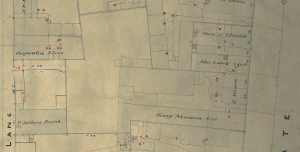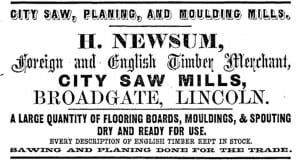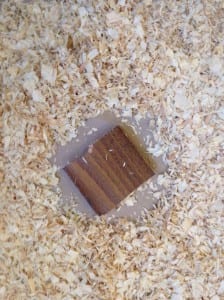A Framing Statement
‘…alter the conventional spatial practices of performance to enhance both the relationship between performers and audience and the performances engagement with its space and site of production.’ (Harvie et al, 2006, 148)
‘The Lincoln Drill Hall was built in 1889-90 by Mr Joseph Ruston and his volunteers and cost a total £10,000.’ (Lincoln Drill Hall, 2016) It has been used as a military and police training hall, a place for great entertainment, a gentleman’s club and more recently a place for a cup of coffee or a baby disco. With all this taken into account, I wanted to look into what had been there in the past, before The Drill Hall was even thought about and starting to be built. My performance, Wooden Voices, was the outcome of this research into the foundations of the site. My site specific piece was based around the past, the people and the place. After going to the Lincolnshire Archives I discovered the before The Drill Hall, a Steam Sawmill existed on the site. It was owned by a gentleman named Mr Henry Newsum. This was the main resource of Wooden Voices.
I made Wooden Voices a durational piece lasting a total of 5 hours and it showcased me performing a task, and the task was taking a whole wooden table and sawing it up into as many pieces as possible. There was no live speech apart from me saying four words; Look, Listen, Smell, and Touch. This was due to the state of the room that I was in. My task took place in The Blue Room at The Drill Hall on the 4th of May. When coming into my performance, I did not want the audience to feel like it was compulsory that they do something, to take part, I wanted them to feel immersed in the site and its history and also to feel that they could come and go as they please.
My piece was influenced by four amazing site specific artists / companies; Maria Fusco, Janet Cardiff, Talking Birds and Reckless Sleepers all for many different reasons. Maria Fusco and her piece Master Rock influenced me through the use of accounts of people from the past and giving a voice to the voiceless, Janet Cardiff for her use of technology, Talking Birds with their ability to bring past places of a site back to life and also showcasing accounts of past people and Reckless Sleepers because of the materials they used in their piece A String Section and what they did with these materials.
An Analysis of Process
However before my research on Henry Newsums Sawmill, I had another idea to recreate one of the music festivals that took place at the Drill Hall. At the trip over to Lincolnshire archives there were some programs for music competitions and festivals that included choirs, bands and solo singers around the early 1800’s. I decided not to go with this idea as after some research, it proved quite difficult to find the songs and music that would have been played at the concerts. Sticking with the music idea though, I also looked down the route of The Rolling Stones concert that took place on 31st December 1963. It was a very iconic moment in the Drill Halls history so I thought that it would be good to highlight it, however I was not able to come up with any original ideas that would do justice to such an occasion. There had also been a performance last year as part of the site specific module that was dedicated to The Rolling Stones event so I decided that I wanted to go for a more original idea, a topic of the history that had been explored before.
So after all this, I remembered from when we went to the archives that the guide, Adrian Wilkinson, mentioned something about a Sawmill. That is when I decided to do further research, to make sure that it definitely existed, where exactly it was on the site of The Drill Hall and when it was there. My first port of call to discover this kind of information was the library, I wanted to see if they had any maps that showed where the Sawmill was. I wanted as well to see if they any newspaper clippings or any other sources that would give physical proof of Henry Newsums Sawmill. However I did experience some issues whilst trying to find information about the establishment. The library staff were having a lot of trouble with finding any documents relating to the Sawmill. They had a lot of maps of the Broadgate / Free School Lane area, however none of them were showing any proof of the company and its foundations. Although they tried very hard to find evidence, it was looking like they did not have anything for me. I could have just accepted that there was no proof and just create my performance regardless, but I wanted hard evidence that this place of work, in fact, existed.
So I got back in contact with Adrian from the Lincolnshire Archives to see if he had anything regarding the Sawmill’s existence, and with luck he did. Even though he only had one document from an old court case from a worker, it was enough, as you can see in the picture of the document below, it has a picture of a map showing exactly where the Sawmill once existed.
Plan of Henry Newsum works, 1880 http://www.itsaboutlincoln.co.uk/h-newsum–sons-ltd.html
Also after doing some further research online I found a newspaper advert for Henry Newsums Company as you can see above which was more proof for me and more information, as it says where exactly it was and that was on the Broadgate side of the site. Lastly, one very important detail that I learned is that the Sawmill burnt down, the source gave me dates also as it states that ‘The company of H Newsum, Sons & Co was established in 1856 by Henry Newsum of Rotherham in Broadgate, Lincoln. These works were destroyed by fire in 1874, the Drill Hall was built on the site…’ (It’s About Lincoln, 2016) all of this information was crucial to my process and enough for me to start creating my piece, I had my initial idea, at this point it was time to start bringing it to life.
I came to the conclusion quite quickly that this type of establishment does not really exist anymore and my first thought was, what is a Steam Sawmill? So I researched what goes into the process and what this type of work entails. I came across a breakdown of the process of wooden logs at sawmills. This specific procedure used words such as ‘felling, limbing, debarking, decking, trimming, drying and planing’ (Wikipedia, 2016). As well as these words and the way that they explain the process, to me came across as the wooden logs are being put through a cleansing procedure. This gave me a feeling that the trees could almost being portrayed as humans, or having human feelings. In one of our seminars Michael Pinchbeck, our tutor for this module, said something that really resonated in my mind with thoughts to my performance and that is ‘giving a voice to the voiceless’ (2016). Following this we, as a class, did research into Maria Fusco’s performance Master Rock. This was a major influence in my piece as Master Rock was made up of accounts. These speeches blossomed from three elements towards the making of the Cruachan Power Station and the “tunnel tigers” that made it possible to get to the power station. The station existed almost a mile beneath Scotland’s highest mountain, Ben Cruachan. The accounts that took place in the performance were ‘…three distinctive voices: Irish actor Lalor Roddy as John Mulholland, one of the few surviving tunnel tigers; poet Denise Riley as Elizabeth Falconer, an amateur artist who made a vast marquetry mural inside the turbine hall; and musician Ceylan Hay as the voice of the ancient granite.’ (Artangel, 2015). All of this information influenced me and I decided to do something very similar. In my piece I had three accounts; one from the perspective of the tree logs which gives the idea of giving a voice to the voiceless, one on behalf of Henry Newsum and the other from a worker at the sawmill. Each of them were spoken by different voices which were me, my dad and my boyfriend. I wanted to do this because in Master Rock, all the voices are distinctive from one another, you can tell which one is which. I wanted the same effect of different tones, volumes and depths. Furthermore I decided that I wanted these pre-recorded accounts to be showcased via a speaker. Janet Cardiff uses many types of technology in her performances, some of which are using speakers or headphones. I wanted to use a speaker for mine as I wanted audience’s members to all embrace the feelings of the accounts at the same time, rather than giving them headphones where they almost became solo audience members. I also wanted the audience members to feel immersed within the whole space and headphones I felt might have taken that away.
Staying along the lines of elements of my performance that were thanks to influences, probably the most important feature of my piece was influenced by a Reckless Sleepers performance named A String Section. In this piece, the performers sit on wooden chairs and saw the legs off. I liked the idea of doing something like this and the materials used; wood and saws. From this I made the decision to use wooden furniture, in particular I chose a wooden table, and over the five hours, I was going to carry out the task of trying to saw the table into as many pieces as possible. I wanted to do this because the materials used at the Sawmill would’ve be one or many saws, steam powered and hand held, and obviously the main material would’ve been wood. Lastly, another very important influence for me was Talking Birds and their performance Wanderlust. This is due to their prime aim of bringing the past of the site back to life. The piece was ‘Made in, for and about the South Bay Underground Car Park in Scarborough in the depths of winter, Wanderlust told the story of a man who had been parked there indefinitely.’ (Talking Birds, 2016). However after doing further research into the site they discovered that is has had a couple other identities beforehand that turned out to be an Amusement park and an Aquarium. Through their performance ‘Wanderlust allowed all three of these incarnations to take turns to surface.’ (Talking Birds, 2016). I wanted to take influence from this and delve further and look into rather than the history of The Drill Hall, I wanted my performance to be ‘…site-oriented, site-referenced, site-conscious, site-responsive, site-related. (Pearson, 2010, 1) and take on the foundations of the site and what existed there before.
When I put all this together, I had decided that I was going to completely transform the space. I was to cover the floor in sawdust and have wooden panels all around the space to bring the smell of cut wood into the atmosphere. I also had planned to have the speaker showcasing the three accounts and have a projector showing a video of Steam Sawmill in action. Additionally I would be in the space, sawing up the table with a hand saw, only saying the words; look, listen, smell and touch to highlight the important elements that would immerse the room and the audience. The whole aim for my piece was to make the audience feel like Henry Newsums Sawmill had been brought to life and also to inform them of what was before as not many people would have known that the sawmill even existed. However in the end I had decided to keep almost all of the elements I previously mentioned except for the projector showing the footage of Newsums sawmill. I decided to take the video out due to wanting to keep it simple. I wanted the audience just to focus on the task in process, the voices of the accounts and the environment surrounding. The reason I also took the footage out is that Henry Newsums Sawmill was, obviously, an English establishment and the people that were in the video looked very American so it did not look right and fit into the performance. However I very much liked the sound track of the video so I used the sound as part of the accounts playing on the speaker to add to the feel of the space.
In the weeks leading up to my performance, I was practising sawing up pieces of wood, as it is not something that I do very often, if not ever. I did this to learn how to start sawing the table in my performance, as I pointed out I have never really sawn anything before so I needed to learn what would be the best way to do it so it was polished for the performance. I also created small patches of sawdust in the drill hall and closed the door for a few minutes to see how well the smell took hold of the room. It was very hard to rehearse anything else due to the quantity of materials I would have needed in terms of the table and sawdust, so I stuck to smaller versions of these elements.
A Performance Evaluation
The final performance I feel didn’t have as many audience members as I had hoped, however people that did show up involved themselves in the way I had wished. One audience member knelt down and felt the sawdust, picked it up and sprinkled it on the floor, feeling the texture of it. Most stood and listened to the accounts and took in the atmosphere of the room. One audience member actually picked up a part of the table that I had sawn off and made a space in the sawdust and placed it in the middle as you can see below.
(Millana Park, 2016)
Moreover, when speaking some audience members afterwards, they said that they felt immersed in the piece and said that it captured there attention intensively which they were shocked about due to its simplicity.
One thing that I was glad about is that I was able to saw up most of the table, not all of it but that was never my intention, to me it didn’t matter how much was sawn. On the other hand I did have a hard time detaching the legs from the table, I should have loosen the screws prior to the performance and it caused a delay in my piece. Another thing that I could have improved as well is the gloves that I wore didn’t fit very well so I kept having to take them off which in the end resulted in me cutting my finger.
Overall, site specific performance has opened my eyes to what a performance could be, it doesn’t have to be in a theatre, with lights and comfy audience chairs, theatre and history can go hand in hand to create an informative and imaginative piece of work. Site specific performance has ‘expanded ideas of theatre beyond the stage into galleries and […] public locations…’ (Keldan et al, 2006, 12) The boundaries can be broken and ones thought process can be free to explore all elements of one place in every aspect; its history, meaning and its value of being a non-traditional venue for theatre works.
Bibliography
Allain, P. and Harvie, J. (2006) The Routledge Companion to Theatre and Performance. Abingdon: Routledge.
Artangel (2016) Maria Fusco: Master Rock. [online] Available from https://www.artangel.org.uk/project/master-rock/ [Accessed 10th May 2016].
Keldan, L. (2006) Introduction in Performance and Place. Basingstoke: Palgrave Macmillan.
Its About Lincoln (2016) H Newsum and Sons Ltd. [online] Available from http://www.itsaboutlincoln.co.uk/h-newsum–sons-ltd.html [Accessed 10th May 2016].
Lincoln Drill Hall (2016) The Venue and its History. [online] Available from http://www.lincolndrillhall.com/about-us/the-venue-its-history [Accessed 10th May 2016].
Pearson, M. (2010) Site-Specific Performance. Basingstoke: Palgrave Macmillan.
Talking Birds (2016) Site-specific and site-responsive works. [online] Available from http://www.talkingbirds.co.uk/ [Accessed 10th May 2016].
Wikipedia (2016) Sawmill. [online] Available from https://en.wikipedia.org/wiki/Sawmill [Accessed 10th May 2016].


